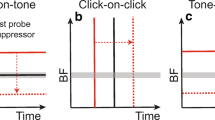Abstract
The mechanical tuning of the basilar membrane has not been shown to be sharp enough to explain the very narrow tuning curves observed in primary auditory fibers. A mechanism for sharpening of the frequency selectivity or an unknown “second filter” is therefore assumed to exist in the cochlea. In the present paper, several theories for frequency selectivity sharpening in the cochlea are studied with the aid of a basilar membrane model. It is shown that the model proposed by Zwislocki (1974) for interaction between inner and outer hair cells results in the greatest increase in selectivity. It is also shown that nonlinear basilar membrane motion may very well explain the discrepancy between mechanical and neural tuning. Besides an increased selectivity at low sound intensities due to an increased low-frequency cut-off slope in the frequency transfer function, nonlinear basilar membrane motion also results in an increased high-frequency cut-off slope not present in other models for frequency selectivity sharpening.
Similar content being viewed by others
References
Békésy,G.von: Experiments in hearing. E. G.Wever, ed. New York: McGraw-Hill 1960
Dallos,P., Billone,M.C., Durrant,J.D., Wang,C.-Y., Raynor,S.: Cochlear inner and outer hair cells: functional differences. Science 177, 356–358 (1972)
Dallos,P.: The auditory periphery: biophysics and physiology. New York: Academic Press 1973
Evans,E.F.: Cochlear nerve and cochlear nucleus. In: Handbook of sensory physiology, Vol. V. Keidel,W.D., Neff,W.D., eds Berlin-Heidelberg-New York: Springer 1975
Evans,E.F., Wilson,J.P.: Frequency selectivity of the cochlea. In: Basic mechaisms in hearing, pp. 519–551. A. R.Møller, ed. New York: Academic Press 1973
Hall,J.L.: Two-tone distortion products in a nonlinear model of the basilar membrane. J. Acoust. Soc. Amer. 56, 1818–1828 (1974)
Hall,J.L.: Spatial differentiation as an auditory second filter. Assessment on a nonlinear model of the basilar membrane. J. Acoust. Soc. Amer. 61, 520–524 (1977a)
Hall,J.L.: Two-tone suppression in a nonlinear model of the basilar membrane. J. Acoust. Soc. Amer. 61, 802–809 (1977b)
Johnstone,B.M., Tylor,K.J., Boyle,A.J.F.: Mechanics of the guinea pig cochlea. J. Acoust. Soc. Amer. 47, 504–509 (1970)
Khanna,S.M., Sears,R.E., Tonndorf,J.: Some properties of longitudinal shear waves: A study by computer simulation. J. Acoust. Soc. Amer. 43, 1077–1084 (1968)
Kiang,N.Y.-S., Sachs,M.B., Peake,W.T.: Shapes of tuningcurves for single auditory nerve fibers. J. Acoust. Soc. Amer. 42, 1341–1342 (1967)
Kim,D.O.: A nonlinear model for basilar membrane motion and related phenomena of single cochlear nerve fibers. Thesis: Washington University, Sever Institute of Technology, St. Louis, Miss. 1972
Møller,A.R.: Coding of sounds in lower levels of the auditory system. Quart. Rev. Biophys. 5, 59–155 (1972)
Nilsson,H.G., Møller,A.R.: Linear and nonlinear models of the basilar membrane motion. Biol. Cybernetics 27, 107–112 (1977)
Peterson,L.C., Bogert,B.P.: A dynamical theory of the cochlea. J. Acoust. Soc. Amer 22, 369–381 (1950)
Rhode,W.S.: Observations of the vibration of the basilar membrane in squirel monkeys using Mössbauer technique. J. Acoust. Soc. Amer. 49, 1218–1231 (1971)
Russell,I.J., Sellick,P.M.: Tuning properties of cochlear hair cells. Nature 267, 858–860 (1977)
Schroeder,M.R.: An integrable model for the basilar membrane. J. Acoust. Soc. Amer. 53, 429–434 (1973)
Spoendlin,H.: Structural basis of perioheral frequency analysis. In: Frequency analysis and periodicity detection inhearing. Plomp,R., Smoorenburg,G.F., eds. Leiden: A. W. Sijthoff 1970
Zweig,G., Lipes,R., Pierce,J.R.: The cochlear compromise. J. Acoust. Soc. Amer. 59, 975–982 (1976)
Zwislocki,J.J., Sokolich,W.G.: Velocity and displacement response in auditory nerve fibers. Science 182, 64–66 (1973)
Zwislocki,J.J.: A possible neuro-mechanical sound analysis in the cochlea. Acoustica 31, 354–359 (1974)
Author information
Authors and Affiliations
Rights and permissions
About this article
Cite this article
Nilsson, H.G. A comparison of models for sharpening of the frequency selectivity in the coachlea. Biol. Cybernetics 28, 177–181 (1978). https://doi.org/10.1007/BF00337139
Received:
Issue Date:
DOI: https://doi.org/10.1007/BF00337139




